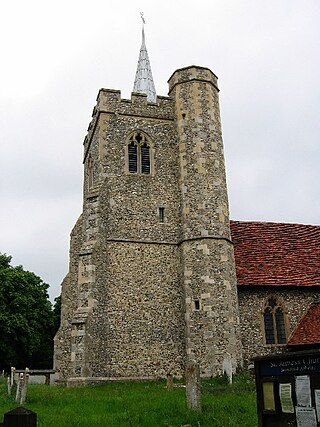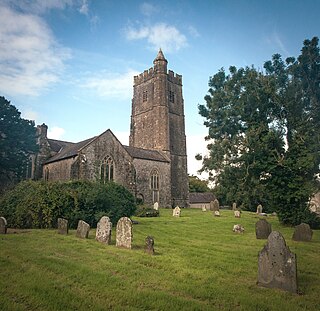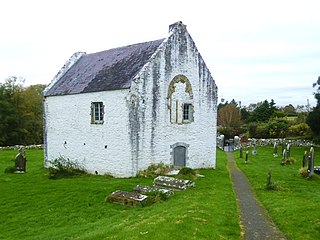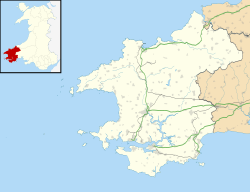
Earl Cawdor, of Castlemartin in the County of Pembroke, is a title in the Peerage of the United Kingdom. It was created in 1827 for John Campbell, 2nd Baron Cawdor.

Nevern is both a parish and a community in Pembrokeshire, Wales. The community includes the settlements of Felindre Farchog, Monington, Moylgrove and Bayvil. The small village lies in the Nevern valley near the Preseli Hills of the Pembrokeshire Coast National Park 2 miles (3 km) east of Newport on the B4582 road.

The Stackpole Estate is located between the villages of Stackpole and Bosherston in Pembrokeshire, Wales, within the Pembrokeshire Coast National Park. It is situated within the community of Stackpole and Castlemartin.

Bosherston is a village and parish in Pembrokeshire, Wales, within the Pembrokeshire Coast National Park.

Walton East is a small rural village and parish established around a church at least as early as Norman times. It is 2 miles (3.2 km) southwest of Llys y Fran and 1+1⁄2 miles (2.4 km) north of Clarbeston Road and in Wiston community in Pembrokeshire, Wales.

Carew is a village, parish and community on an inlet of Milford Haven in the former Hundred of Narberth, Pembrokeshire, West Wales, 4 miles (6.4 km) east of Pembroke. The eastern part of the parish is in the Pembrokeshire Coast National Park.

St Mary's Church is an Anglican parish church in Nantwich, Cheshire, England. The church is recorded in the National Heritage List for England as a designated Grade I listed building. It has been called the "Cathedral of South Cheshire" and it is considered by some to be one of the finest medieval churches, not only in Cheshire, but in the whole of England. The architectural writer Raymond Richards described it as "one of the great architectural treasures of Cheshire", and Alec Clifton-Taylor included it in his list of "outstanding" English parish churches.

St Deiniol's Church, Hawarden, is in the village of Hawarden, Flintshire, Wales. It is the parish church of the rectorial benefice of Hawarden in the deanery of Hawarden, the archdeaconry of Wrexham, and the diocese of St Asaph. The church has associations with W. E. Gladstone and his family, and is designated by Cadw as a Grade II* listed building.

Warren is an ancient parish in the community of Stackpole and Castlemartin, in the most southerly part of Pembrokeshire, Wales. Its northern edge is 5 miles (8 km) south of Pembroke and its southern edge reaches the sea at Flimston Bay. It is bordered by Castlemartin to the west, St Twynnells to the east and Monkton to the north.

St James' Church is the Church of England parish church of Longborough, Gloucestershire, England. It is in the deanery of Stow, the archdeaconry of Cheltenham and the diocese of Gloucester. Its benefice is combined with those of St David, Moreton-in-Marsh, St Mary, Batsford, St Thomas of Canterbury, Todenham, and St Leonard, Lower Lemington. It contains fabric from the 12th century and is recorded in the National Heritage List for England as a designated Grade I listed building.

St Lawrence's Church is a redundant Anglican church in the parish of Snarford, Lincolnshire, England. It is recorded in the National Heritage List for England as a designated Grade I listed building, and is under the care of the Churches Conservation Trust. The church stands to the north of the A46 road between Market Rasen and Lincoln. It is a medieval building containing impressive 16th- and 17th-century monuments.

St James' Church is a redundant Anglican church near the village of Stanstead Abbotts, Hertfordshire, England. It is recorded in the National Heritage List for England (NHLE) as a Grade I listed building, having been designated in 1967. The church is under the care of the Churches Conservation Trust. The church is about 1 mile (1.6 km) to the southeast of the village on the north side of the B181 road. It stands on the top of a hill overlooking the Lea marshes.

St Decuman's is a Grade I listed building in Rhoscrowther, Pembrokeshire, Wales.

St Mary's Church, Carew, is the parish church of Carew, Pembrokeshire, Wales and a Grade I listed building. Lewis's Topographical Dictionary of Wales states that the church is dedicated to St John the Baptist, but the reason for this is unclear. The church is in the small village of Carew Cheriton in the southwest of the parish.

The Church of Saint Mary the Virgin is the Church of England parish church of Bampton, West Oxfordshire. It is in the Archdeaconry of Dorchester in the Diocese of Oxford.

Old Mortuary Chapel is a medieval Grade I listed building in St Mary's churchyard, Carew, Pembrokeshire, Wales.

St Michael's Church is a Grade I listed building and parish church in the community and parish of Rudbaxton in Pembrokeshire, Wales. The building dates from the 15th century, and has a 12th-century font. It was listed on 1 March 1963 as a fine example of a substantial mediaeval double-nave church with important memorials.

St David's Church, Hubberston is the parish church of Hubberston, a village on the north bank of the Milford Haven Waterway, in south Pembrokeshire, Wales. The church has 15th century origins, was subsequently renovated and restored, and is a Grade I listed building.

The Church of St Nicholas & St John, formerly the Priory Church of St Nicholas, is the parish church of Monkton, a village on the south bank of the Milford Haven Waterway, in south Pembrokeshire, Wales. The church's medieval origins link it to Monkton Priory, founded in the 11th century. It is a Grade I listed building.




















